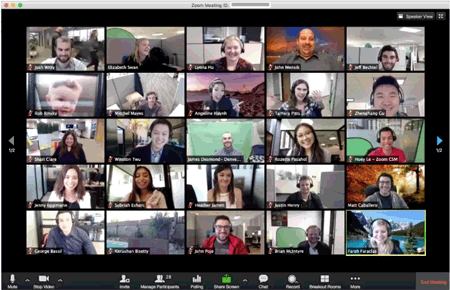Going to Work: a commute of ten miles or ten feet?
Data from the Center’s new Coronavirus Disruption Project suggests that many Americans will never go back to daily commutes to work in offices, and that’s not a bad thing, either.
By Jeffrey Cole
The phrase “going to work” has taken on an entirely new meaning.
Two months ago, most of us had never heard of Zoom. Now, for those who are working at home during the Coronavirus pandemic, Zoom is a way of life.
 Zoom has moved into a rarefied atmosphere of the tiny list of companies whose brands that have become verbs: Google, Xerox, Uber. The invitation is not, “do you want to join me in a Zoom Meeting,” but rather, “let’s Zoom.”
Zoom has moved into a rarefied atmosphere of the tiny list of companies whose brands that have become verbs: Google, Xerox, Uber. The invitation is not, “do you want to join me in a Zoom Meeting,” but rather, “let’s Zoom.”
The latest unemployment figures, the highest since the Great Depression, show that about 15% of Americans are unemployed. Other than essential workers (health care, delivery, police, supermarkets), the rest have moved much (if not all) of our jobs online. We made this move in a matter of days without preparation. Many of us did it without any prior experience doing our jobs online.
Data from the Center’s new study with the Interactive Advertising Bureau, “The Coronavirus Disruption Project: Living and Coping During the Pandemic,” shows that moving our work lives online has been a success — particularly compared to other activities we have been compelled to move online, such as school work.
Working online at home has become the new normal, and our study suggests that it may become an established part of employment even after a vaccine makes the coronavirus a thing of the past. That prospect raises some troubling socio-economic divides that may favor the highly educated and affluent while disadvantaging the rest of the work force.
Only some of our jobs can be moved partially or fully online and to home. In our study, we saw that 74% of us say we can do at least a little bit of our jobs online. Twenty-six percent say they can do all of their work online.
That leaves 26% who say they cannot do any of their work online (bus drivers, chefs). Of those with a high school education, 51% say they cannot do any work online.
Raising further class divisions, the people who seem to do best working at home are those who have plenty of space and separation from other people in the household. The fortunate ones, 29%, are those who have a dedicated room and can actually “go to work” in a spare bedroom or dedicated office. Forty-four percent of those working at home over the past eight weeks have part of a room, while 27% have to work “on the fly” in rotating spaces as they become available. Sixty-three percent report that there is some interference from other people in the home. Six percent report a lot of it.
Beyond space, economics also raises concerns about how many Americans have adequate internet connections and equipment to do their jobs. About 13% of American households still do not have broadband. For those who do, their connections have never been tested so severely. A family of four may have one person working online in a Zoom meeting, another “in school” in a Microsoft Teams classroom, and the other two watching HD movies on Netflix and Hulu.
The good news: of those who are working or learning online, even without preparation for sheltering in place, 85% had the necessary computers, scanners and cameras to do their work.
It’s not all bad news
There are lots of things we really like about moving our jobs from the office to our homes. At the top of the list for two-thirds of us is that we no longer have to get in our cars to sit in traffic. We are quickly learning the joys of no gridlock and all the extra time we suddenly have in our lives without a commute. Nothing, however, comes without a price: one-third are concerned that working online erodes the home-workplace boundary. For those who make over $150,000 a year that number jumps to 51%.
___________________________________________________________________________
Data from the Center’s new study with the Interactive Advertising Bureau, “The Coronavirus Disruption Project: Living and Coping During the Pandemic,” shows that moving our work lives online has been a success. Working online at home has become the new normal, and our study suggests that it may become an established part of employment even after a vaccine makes coronavirus a thing of the past. That prospect raises some troubling socio-economic divides that may favor the highly educated and affluent while disadvantaging the rest of the work force.
___________________________________________________________________________
About 60% of us like relaxed dress. One can only wonder how many people in Zoom meetings are wearing pants. Long-term studies of telecommuting have shown that the people who do best are the ones who get up at the same time as if they were commuting to an office. And importantly, they move out of pajamas and bathrobes and into work clothes.
The same 60% also like the ability to control the work environment. At home, you can set the thermostat the way you want and not have to shiver in the cold or sweat in the heat. And just over a third like that working online means being able to avoid irritating colleagues. Evidently, they are not as annoying online.
However, almost half of us don’t like distractions in the home (kids, gardeners, the front door).
What Americans miss
More telling than the things we don’t like about working at home are the things we miss about going into the office or workplace.
Sixty-three percent miss being in a different place during the day. They miss going from home to work, and maybe out to lunch or coffee, and the natural punctuation of the day which we don’t see as much at home. Six in 10 home workers miss interacting with colleagues or customers face-to-face and seeing different people each day rather than the same people at home.
Almost as many miss the structure of the workplace. In all the research on the pandemic, people say that being sheltered at home lacks structure, and many of us miss the regular hours and routines of school, work, shopping, and much more.
Forty percent miss the enjoyable aspects of our commute. This may sound farcical for people who live in Los Angeles or other traffic-infested cities—where commuting means a daily slog of an hour or more each way, moving at a snail’s pace on roads filled with pollution and rage. But for some, a 20-minute drive through moving traffic can be pleasant, providing a much-needed decompression between the workplace and home.
Getting things done
Supervisors have always been suspicious of staff taking their work home instead of coming into the office. Many never fully trusted that work would actually get done and feared employees were watching television or “goofing off.” The biggest concern was that if supervisors could not see the work being done, then it must not really be happening.
The coronavirus pandemic has changed this.
From the employee perspective, 61% say their productivity is the same wherever they work. Of those who say there is a difference, slightly more, 23%, say they are less productive working at home; 17% say they are more productive. Those are actually encouraging numbers for a massive workplace shift that none us were prepared for. Had we been given weeks or months to get ready, we might have made a transition to more effective telecommuting faster and with even higher estimates of productivity.
Since the beginning of the 21st century and the rise of the internet, companies have experimented with allowing some of their teams to work from home, particularly women in late stages of pregnancy and others who could not readily get to work. But not even the greatest science-fiction writers could have envisioned almost the entire workplace being shut down and tens of millions moving work home and online in 7 to 10 days.
When the world returns to some semblance of normal, our research suggests that we won’t see millions of people moving all their work lives to home and the internet. But for the three-quarters of us who can do some work at home, we like the experience, the freedom and flexibility it provides. As we do more and more work at home, our behaviors and the nature of work will evolve to make it at least as productive as working in the office—and without the stress of getting there.
Commercial real estate may be hurt as formal office space shrinks. Business travel may take a permanent hit even after we are willing to travel again, as businesses will have learned that many meetings can be conducted online at enormous cost savings.
Some of the kinks need to be worked out, but the shift to some work at home is likely to be permanent. The pandemic forced a shift that gradual change over the past 20 years could not produce.
There’s no going back.
____________

Jeffrey Cole is the founder and director of The Center for the Digital Future at USC Annenberg.
See all columns from the center.
May 13, 2020

